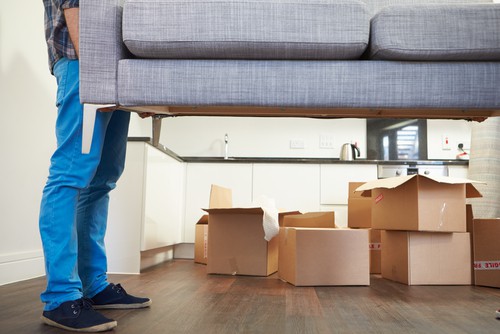
Decking Materials for Rooftop Swimming Pools
September 29, 2023
The Health Benefits of Bamboo Flooring
November 27, 2023Protecting Laminate Floors During a Move

Protecting Laminate Floors During a Move
Protecting Laminate Floors During a Move. Laminate floors are not just a floor covering; they invest in your home’s aesthetic and functional appeal.
They provide a blend of elegance and durability that is hard to beat, often mimicking the look of more expensive hardwood or tile.
Yet, their beautiful surface can be prone to scratching and dents, especially during potentially disruptive activities like moving.
The purpose of this article is to arm you with knowledge and strategies to safeguard your laminate floors during a move, thereby maintaining their pristine condition.
Table of Contents
The Appeal of Laminate Floors
Why Homeowners Choose Laminate Flooring
Laminate flooring has been gaining traction because it provides the appearance of natural wood without the high cost.
Besides affordability, they are also easy to install and maintain. Their water-resistant properties make them suitable for various environments, such as kitchens and bathrooms, extending their appeal beyond living rooms and bedrooms.
Properties Making Laminate Floors Susceptible to Damage
While laminate floors offer durability, they are not invincible. The lamination process involves layers of material fused, and these layers can separate under severe stress or when scratched by sharp objects.
Such vulnerabilities underscore the importance of extra care during activities like moving.
Pre-Move Preparations

Taking Inventory
Documenting each piece of furniture that will be moved can be beneficial for multiple reasons.
It allows you to gauge the level of manpower needed, identify potentially problematic pieces that might require disassembly, and determine what additional protective materials you might need.
A detailed inventory can be a lifesaver on the actual moving day.
Material Preparation
Different types of protection may be needed for varying pieces of furniture.
For example, heavy furniture may require more robust sliders or even a dolly for safer and more efficient movement.
Invest in high-quality protective materials like thick rubber sliders or felt pads for optimal friction resistance. Subpar materials may come off, tear, or disintegrate, leaving your floors unprotected.
Protection Strategies
Use of Furniture Sliders and Pads
Furniture sliders are generally made of strong plastic with a hard rubber surface for maximum durability. They come in various shapes and sizes to fit different kinds of furniture legs.
Felt pads, though less robust, are ideal for lighter pieces of furniture that you might move frequently, like chairs or small tables.
Sliders or pads should be firmly attached to the feet of furniture. Ensure they are the correct size to prevent them from coming loose during the move.
If the slider is too small, it may slip off; if it’s too large, it might snag on the floor, causing more damage.
Temporary Floor Coverings
Multiple types of temporary floor coverings can provide additional protection. Rugs and carpets are better suited for short-distance moves within the house, while thick plastic sheeting can be more practical for larger moves where furniture needs to be taken out of the house.
Install these coverings securely to prevent them from moving during the relocation. Use tape to hold down edges, ensuring that neither the tape nor the covering itself will leave any adhesive residue on the floor.
Lifting, Not Dragging
Whenever feasible, lifting is preferable to dragging. However, lifting should be done correctly to ensure safety.
Lift the furniture from both sides evenly, avoiding tilting or pulling one side, as uneven pressure can lead to dropping the item, causing concentrated damage to the floor.
Proper lifting isn’t just about your safety; it’s also about the security of your floor. Incorrect lifting could lead to a sudden drop, which might crack or deeply dent the laminate.
Always employ the right lifting mechanics: bend at the knees, keep your back straight, and use your legs for lifting, not your back.
Other Precautions

Cleaning the Floor Pre-Move
Cleaning isn’t merely an aesthetic concern. Dust and grit can become abrasive under furniture legs or sliders, leading to fine scratches that mar your laminate’s finish.
Therefore, before initiating the move, sweep and mop the floor to remove any particulates that might cause damage.
Taking Special Care of Corners and Edges
The edges and corners of rooms are often the most vulnerable and overlooked. Using corner guards made of rubber or foam can protect these areas.
Similarly, if you have baseboards or low walls, protective padding can prevent dents and scratches during the hustle and bustle of moving.
Moving Day Best Practices
Even the best-laid plans can go awry if not executed correctly. Therefore, on the day of the move, it’s critical to have effective communication among all people involved. Designate a person to oversee the process, ensuring that everyone is following the protective measures laid out.
Post-Move Assessment and Maintenance
A thorough inspection after the move is essential. Examine your laminate floors for any signs of damage like scratches, dents, or scuff marks. While some minor damages can be fixed using repair kits, severe damage might require professional help. Take photographs of any damaged areas for insurance or professional consultation purposes.
Frequently Asked Questions (FAQs)
Can I Move Heavy Furniture by Myself Without Damaging the Laminate Floor?
Moving heavy furniture by yourself poses a high risk to both your laminate floors and your physical well-being. Therefore, it is highly advisable to seek help, whether it’s from friends or professional movers who are experienced in handling such tasks.
Are There Any Alternatives to Furniture Sliders?
Yes, alternatives like plywood or thick cardboard can be used, but they do not offer the same level of protection as purpose-made sliders. Therefore, they should only be considered as a last resort.
How Do I Fix Minor Damages Post-Move?
There are several laminate floor repair kits available on the market that can fix minor scratches and dents. These often include fillers and colorants that can be mixed to match your floor’s finish.
What Are the Signs of Laminate Floor Damage?
The signs include scratches, dents, discoloration, and, in severe cases, separation of the laminate layers. Immediate attention can prevent further degradation.
Do I Need Professional Help to Ensure Floor Protection During a Move?
If you are moving a large number of heavy items or if you have a particularly intricate floor layout, then professional help would be highly advisable. Experts in the field have the experience and equipment to protect your laminate floors.
Protecting Laminate Floors During a Move – Conclusion

Laminate floors add beauty and elegance to your home, but they require careful handling during a move to maintain their condition.
Through detailed pre-move preparations, strategic protection measures, and post-move assessments, you can minimize the risk of damaging your prized flooring.
A little time and effort invested in safeguarding your laminate floors can save you a considerable amount in repair or replacement costs down the line.
Therefore, every homeowner should make it a priority to be educated and prepared for floor protection during any moving activities.
Are you seeking a professional and reliable laminate flooring installation service in Singapore? Contact us today!



